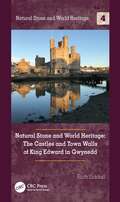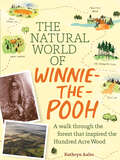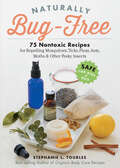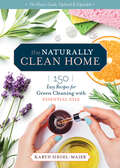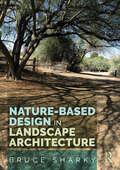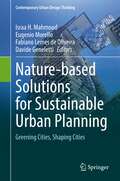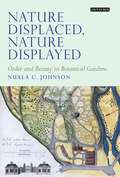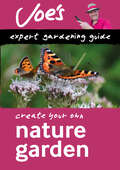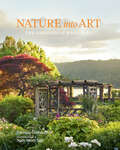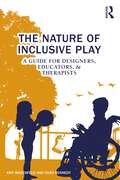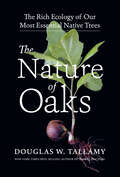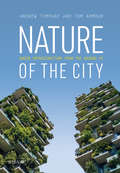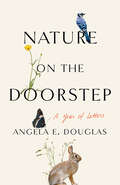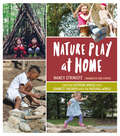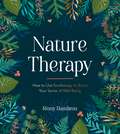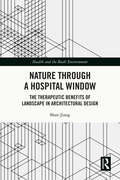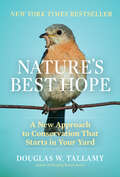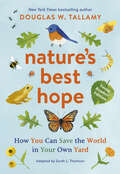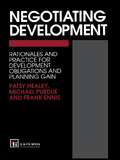- Table View
- List View
Natural Stone and World Heritage: The Castles and Town Walls of King Edward in Gwynedd (Natural Stone and World Heritage)
by Ruth SiddallThis book is about the stone used to build the castles of Edward I in North West Wales. It provides a description of the available geological resources and the building materials used in the construction of Caernarfon, Conwy, Harlech and Beaumaris Castles. It takes a broad view of this subject, placing the stone used in the castles in the context of both earlier and later buildings across the region of study, from the Neolithic up until the present day. The book will serve as a useful source book for geologists, archaeologists, architects, representatives of the natural stone industry, historians and cultural heritage management professionals specifically and for academic and non-academic communities, travellers and tourism industry operators in general.
The Natural World of Winnie-the-Pooh: A Walk Through the Forest that Inspired the Hundred Acre Wood
by Kathryn AaltoA New York Times Bestseller This charmingly illustrated book explores the real landscape of the Ashdown Forest, A. A. Milne's inspiration for the Hundred Acre Wood, the magical realm in which Winnie-the-Pooh and his friends lived and played.
Naturally Bug-Free: 75 Nontoxic Recipes for Repelling Mosquitoes, Ticks, Fleas, Ants, Moths & Other Pesky Insects
by Stephanie L. TourlesProtect yourself, your children, your pets, and your home from bugs — without using harsh or toxic chemicals! Herbalist Stephanie Tourles offers 75 simple recipes for safe, effective bug repellents you can make at home from all-natural ingredients. For protection from mosquitos, ticks, and other biting insects, there are sprays, balms, body oils, and tinctures, with scents ranging from eucalyptus to floral, lemon, vanilla, and woodsy spice. There are also recipes for pets, such as herbal shampoo, bedding formulas, and flea-and-tick collars and powders. And Tourles includes repellents for the home, such as sachets that repel moths, carpet powders that repel fleas and ants, and essential oil repellents to keep your pantry pest-free. A detailed ingredient dictionary explains the properties of all the herbs, essential oils, and other key ingredients.
The Naturally Clean Home, 3rd Edition: 150 Nontoxic Recipes for Cleaning and Disinfecting with Essential Oils
by Karyn Siegel-MaierThe third edition of this best-selling book features greener formulas for homemade cleaning products, expanded information on using essential oils for cleaning and sanitizing, and updated packaging recommendations and preparation guidelines for a zero-waste approach.
Nature-Based Design in Landscape Architecture
by Bruce SharkyNature-Based Design in Landscape Architecture showcases a range of built works designed by landscape architects from many countries of the world representing diverse environmental regions and uses. These projects demonstrate the transformative potential of a nature-based approach to landscape architecture.The nature-based design approach supports and encourages natural regeneration with a view to promoting sustainable environments, preserving natural resources, and mitigating the impacts of climate change and development. The projects selected for this book demonstrate the potential of nature-based landscape design to support healthy, natural and managed ecosystems, sequester carbon, and support the recovery of biodiversity. In addition to examples of design-led environmental interventions, Nature-Based Design in Landscape Architecture, the book, also demonstrates the potential for nature-based design to improve people’s relationship with their surroundings by encouraging them to be active participants in their communities. As such, each project featured in the book promotes a discussion around future scenarios in which landscape architects can and will be engaged, from minimizing environmental impact through sustainable design to fostering social justice through community engagement.This book will be a welcome supplement for undergraduate landscape architecture, survey or design studio courses, and may also be used at the master’s degree level either as part of a landscape architecture survey seminar or early design studio.
Nature-Based Design in Landscape Architecture
by Bruce SharkyNature-Based Design in Landscape Architecture showcases a range of built works designed by landscape architects from many countries of the world representing diverse environmental regions and uses. These projects demonstrate the transformative potential of a nature-based approach to landscape architecture.The nature-based design approach supports and encourages natural regeneration with a view to promoting sustainable environments, preserving natural resources, and mitigating the impacts of climate change and development. The projects selected for this book demonstrate the potential of nature-based landscape design to support healthy, natural and managed ecosystems, sequester carbon, and support the recovery of biodiversity. In addition to examples of design-led environmental interventions, Nature-Based Design in Landscape Architecture, the book, also demonstrates the potential for nature-based design to improve people’s relationship with their surroundings by encouraging them to be active participants in their communities. As such, each project featured in the book promotes a discussion around future scenarios in which landscape architects can and will be engaged, from minimizing environmental impact through sustainable design to fostering social justice through community engagement.This book will be a welcome supplement for undergraduate landscape architecture, survey or design studio courses, and may also be used at the master’s degree level either as part of a landscape architecture survey seminar or early design studio.
Nature-based Solutions for Sustainable Urban Planning: Greening Cities, Shaping Cities (Contemporary Urban Design Thinking)
by Israa H. Mahmoud Eugenio Morello Fabiano Lemes de Oliveira Davide GenelettiUrban greening policies and measures have recently shown a high potential impact on the design and reshaping of the built environment, especially in urban regeneration processes. This book provides insights on analytical methods, planning strategies and shared governance tools for successfully integrating Nature-Based Solutions (NBS) in the urban planning practice. The selected contributions present real-life application cases, in which the mainstreaming of NBS are investigated according to two main challenges: the planning and designing of physical and spatial integration of NBS in cities on one side, and the implementation of suitable shared governance models and co-creation pathways on the other. Chapter 5 is available open access under a Creative Commons Attribution 4.0 International License via link.springer.com.
Nature by Design: The Practice of Biophilic Design
by Stephen R. KellertBiophilia is the theory that people possess an inherent affinity for nature, which developed during the long course of human evolution. In recent years, studies have revealed that this inclination continues to be a vital component to human health and wellbeing. Given the pace and scale of construction today with its adversarial, dominative relationship with nature, the integration of nature with the built environment is one of the greatest challenges of our time. In this sweeping examination, Stephen Kellert describes the basic principles, practices, and options for successfully implementing biophilic design. He shows us what is—and isn’t—good biophilic design using examples of workplaces, healthcare facilities, schools, commercial centers, religious structures, and hospitality settings. This book will to appeal to architects, designers, engineers, scholars of human evolutionary biology, and—with more than one hundred striking images of designs—anyone interested in nature†‘inspired spaces.
Nature Displaced, Nature Displayed: Order and Beauty in Botanical Gardens (Tauris Historical Geographical Series)
by Nuala C. JohnsonBotanical gardens brought together in a single space the great diversity of the earth's flora. They displaced nature from forest and foothill and re-arranged it to reveal something of the scientific principles underpinning the apparent chaos of the wild. Nature Displaced, Nature Displayed shows how the design and display of such gardens was not determined by scientific principles alone. Through a study of three botanical gardens - belonging to the University of Cambridge, the Royal Dublin Society, and the Belfast Natural History Society - the author shows how the final outcome involved a complex interplay of ideas about place, identity, empire, botanical science, and especially aesthetics, creating spaces that would educate the mind as well as please the senses. This highly engaging book offers a wealth of fresh insights into both the history and development of botanical gardens as well as connections between science and aesthetics. 'Nuala Johnson's masterful ethnography of three sites where the canons of science and aesthetics are refracted and blurred demonstrates why a geographical imagination matters. This is comparative history at its best.'James S. Duncan, University of Cambridge
Nature Garden: Create Your Own Green Space With This Expert Gardening Guide (Collins Gardening)
by Joe Swift Collins BooksSupport and protect the natural world with tips from expert gardener Joe Swift. With around 16 million UK gardens covering a larger area than all our nature reserves, you could say our largest nature reserve is one big garden! In this practical guide, Joe shows you how to support and protect our rich and varied wildlife habitats.
Nature into Art: The Gardens of Wave Hill
by Thomas ChristopherWave Hill is an iconic public garden located in the Bronx. In this lushly-illustrated, inspirational guide, gardeners will discover the plants and designs that define the garden and learn how to recreate the aesthetic sensibilities at home.
The Nature of Inclusive Play: A Guide for Designers, Educators, and Therapists
by Amy Wagenfeld Chad KennedyThis book provides designers, planners, educators, and therapists with the practical information required to remove inequity in outdoor spaces, by creating inviting and inclusive solutions so that all children and their families, regardless of situation or circumstance, can experience the joys and benefits of outdoor play without stigma. It is the first of its kind, co-written by an occupational therapist and landscape architect both with proven expertise in inclusive play space design. The Nature of Inclusive Play fills an untapped niche in promoting the value of outdoor play. It focuses on what embodies play and shows how, through inclusive outdoor play design, developmental skills can be enriched. The topics covered in the book include: • a discussion of the health benefits associated with being outdoors • the history of and value of play • an overview of typical child development • the importance of sensory regulation • an inclusive design review process • design guidelines. All topics are supplemented with nine applicable case studies of inclusive outdoor play spaces with features that reflect inclusive+ principles, including examples from North America and Africa. It is a much-needed guide for landscape architects, urban planners, allied health care professionals, early childhood educators, academics, and students.
The Nature of Inclusive Play: A Guide for Designers, Educators, and Therapists
by Amy Wagenfeld Chad KennedyThis book provides designers, planners, educators, and therapists with the practical information required to remove inequity in outdoor spaces, by creating inviting and inclusive solutions so that all children and their families, regardless of situation or circumstance, can experience the joys and benefits of outdoor play without stigma. It is the first of its kind, co-written by an occupational therapist and landscape architect both with proven expertise in inclusive play space design. The Nature of Inclusive Play fills an untapped niche in promoting the value of outdoor play. It focuses on what embodies play and shows how, through inclusive outdoor play design, developmental skills can be enriched. The topics covered in the book include: • a discussion of the health benefits associated with being outdoors • the history of and value of play • an overview of typical child development • the importance of sensory regulation • an inclusive design review process • design guidelines. All topics are supplemented with nine applicable case studies of inclusive outdoor play spaces with features that reflect inclusive+ principles, including examples from North America and Africa. It is a much-needed guide for landscape architects, urban planners, allied health care professionals, early childhood educators, academics, and students.
The Nature of Oaks: The Rich Ecology of Our Most Essential Native Trees
by Douglas W. TallamyDoug Tallamy, the New York Times bestselling author of Nature's Best Hope and Bringing Nature Home, reveals the ecological importance of the mighty oak tree.
Nature of the City: Green Infrastructure from the Ground Up
by Tom Armour Andrew TempanyThis is a practical guide to delivering green infrastructure from the ground up and bringing nature in to the built environment. Exploring the process of delivery through an array of design approaches and case studies, it demystifies the concept and provides the tools for practical implementation - highlighting the challenges and opportunities on both small and large projects.
Nature of the City: Green Infrastructure from the Ground Up
by Tom Armour Andrew TempanyThis is a practical guide to delivering green infrastructure from the ground up and bringing nature in to the built environment. Exploring the process of delivery through an array of design approaches and case studies, it demystifies the concept and provides the tools for practical implementation - highlighting the challenges and opportunities on both small and large projects.
Nature on the Doorstep: A Year of Letters
by Angela E. DouglasNature on the Doorstep reveals the simple pleasures of paying attention to the natural world in one's own backyard over the course of a year. In weekly letters, Angela Douglas shares the joys and curiosities of a decidedly ordinary patch of green in upstate New York cultivated through the art of "strategic neglect"—sometimes taking a hand to manage wildlife, more often letting nature go its own way. From the first flowers of spring to cardinals singing in the winter, Douglas shows us the magic of welcoming unexpected plant and animal life into one's backyard. A paean to the richness we find when we stop to look and let be, Nature on the Doorstep celebrates the role humble backyards play both in conservation efforts and in an expanded appreciation of the living world.
Nature Play at Home: Creating Outdoor Spaces that Connect Children with the Natural World
by Nancy StrinisteNature Play at Home is a hardworking and inspiring guide filled with ideas for incorporating natural materials and play structures into your yard to get your kids outside exploring and learning.
Nature Therapy: How to Use Ecotherapy to Boost Your Sense of Well-Being
by Rémy DambronNature therapy is the practice of reconnecting with the natural world to refresh your physical and mental well-being. Including tips to help you discover your connection with the outdoors, activity inspiration and a holistic approach to wellness, this book is the ultimate guide to unlocking the transformative power of nature.
Nature through a Hospital Window: The Therapeutic Benefits of Landscape in Architectural Design (Health and the Built Environment)
by Shan JiangAdopting an evidence-based approach, this book uses two state-of-the-art experimental studies to explore nature’s therapeutic benefits in healthcare environments, emphasizing how windows and transparent spaces can strengthen people–nature interactions. High-quality, supportive, and patient-centred healthcare environments are a key priority for healthcare designers worldwide, with ageing populations creating a demand for remodeled and updated facilities. The first study demonstrates individual psychophysiological responses, moods, and preferences in simulated hospital waiting areas with different levels of visual access to nature through windows, while the second experiment uses cutting-edge immersive virtual reality techniques to explore how gardens and nature views impact people’s spatial cognition, wayfinding behaviors, and experience when navigating hospitals. Through these studies and discussions drawing on architectural theory, the book highlights the important benefits of having access to nature from hospital interiors. This concise volume will appeal to academics and designers interested in therapeutic landscapes and healthcare architecture.
Nature through a Hospital Window: The Therapeutic Benefits of Landscape in Architectural Design (Health and the Built Environment)
by Shan JiangAdopting an evidence-based approach, this book uses two state-of-the-art experimental studies to explore nature’s therapeutic benefits in healthcare environments, emphasizing how windows and transparent spaces can strengthen people–nature interactions. High-quality, supportive, and patient-centred healthcare environments are a key priority for healthcare designers worldwide, with ageing populations creating a demand for remodeled and updated facilities. The first study demonstrates individual psychophysiological responses, moods, and preferences in simulated hospital waiting areas with different levels of visual access to nature through windows, while the second experiment uses cutting-edge immersive virtual reality techniques to explore how gardens and nature views impact people’s spatial cognition, wayfinding behaviors, and experience when navigating hospitals. Through these studies and discussions drawing on architectural theory, the book highlights the important benefits of having access to nature from hospital interiors. This concise volume will appeal to academics and designers interested in therapeutic landscapes and healthcare architecture.
Nature's Best Hope: A New Approach to Conservation That Starts in Your Yard
by Douglas W. TallamyAn urgent and heartfelt call for a new approach to conservation—one that starts in every backyard—from the New York Times bestselling author of Bringing Nature Home.
Nature's Best Hope (Young Readers' Edition): How You Can Save the World in Your Own Yard
by Douglas W. TallamyThis middle grade edition of the groundbreaking bestseller by Doug Tallamy will inspire kids to use their backyard to help save the planet. Douglas W. Tallamy awakened thousands of readers to an urgent situation: wildlife populations are in decline because the native plants they depend on are fast disappearing. His solution? Plant more natives. In this middle grade adaptation of the New York Times bestseller Nature's Best Hope, Tallamy outlines his vision for a grassroots approach to conservation that everyone can participate in regardless of age. In Nature's Best Hope (Young Readers' Edition), Tallamy empowers kids to use their own yards to help combat the negative effects of climate change. He does so by breaking down complex concepts into simple terms and real-world examples that kids can easily grasp. Black and white photographs help further clarify concepts. In addition to sharing the science, Tallamy encourages kids to take direct action. Some of these ideas include planting an oak tree (one of the most important tree species) at home. If that&’s too large of a task, he suggests they can plant asters—a beautiful flower whose pollen bees use to feed their young. By helping the next generation see that they have power and agency over our collective future, this empowering book will drive home the positive point that kids are truly nature&’s best hope.
Negotiating Development: Rationales and practice for development obligationsand planning gain
by F. Ennis Frank Ennis P. Healey Prof Patsy Healey M. PurduePlanning gain is the legal process by which property development is linked to social provisions. This book examines the rationale for planning gain and development obligations and reviews the practice of development negotiation through a wide range of case histories.
Negotiating Development: Rationales and practice for development obligationsand planning gain
by F. Ennis Frank Ennis P. Healey Prof Patsy Healey M. PurduePlanning gain is the legal process by which property development is linked to social provisions. This book examines the rationale for planning gain and development obligations and reviews the practice of development negotiation through a wide range of case histories.
